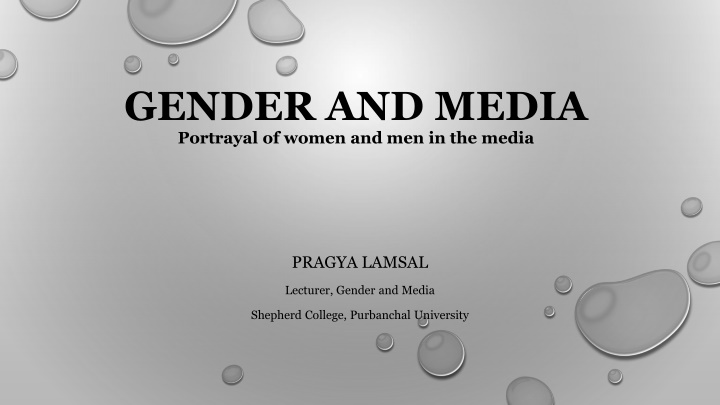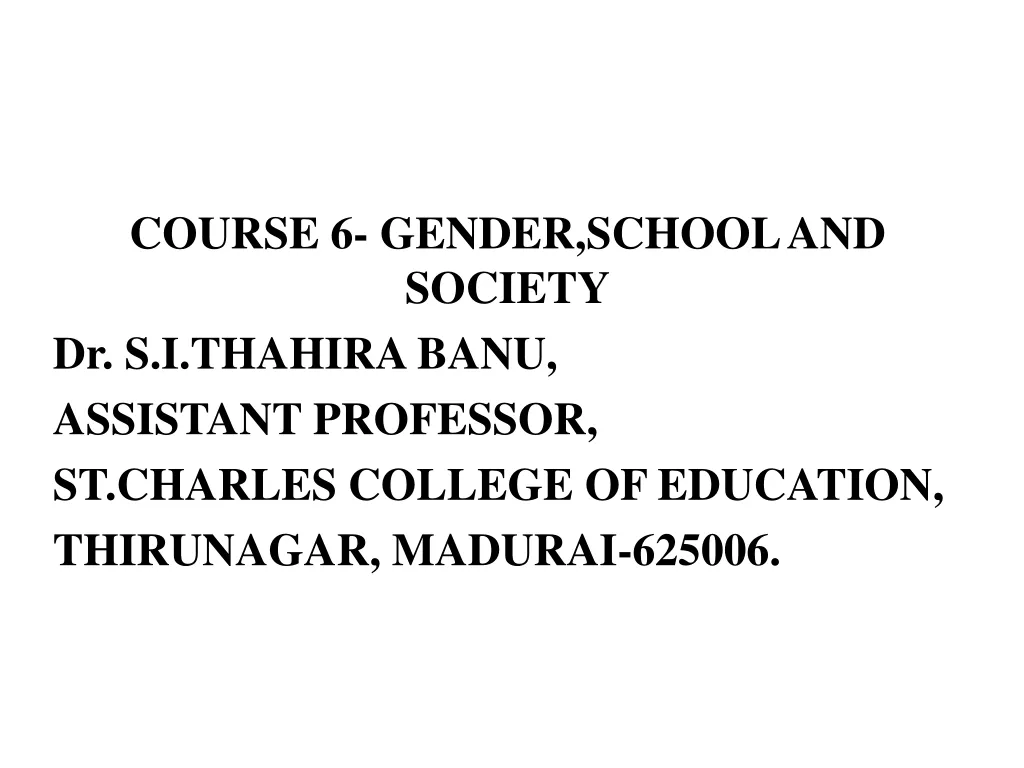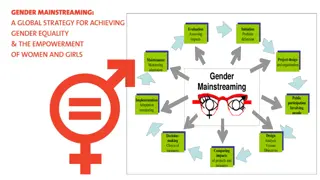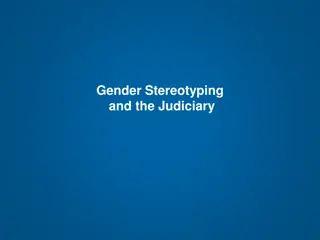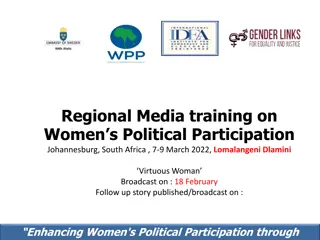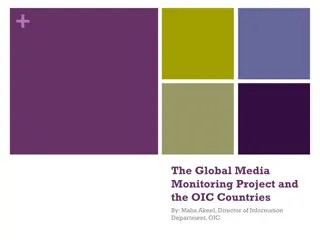Gender and Media Portrayal of Women
The portrayal of women in media, as reflected through studies and research, raises questions about representation, visibility, linguistic framing, and stereotypes perpetuated by the media. Divergent perspectives in media theories showcase the ongoing debate on whether mass media mirrors or creates culture. Gender representation in films further highlights the complexities of how men and women are depicted on screen.
Download Presentation

Please find below an Image/Link to download the presentation.
The content on the website is provided AS IS for your information and personal use only. It may not be sold, licensed, or shared on other websites without obtaining consent from the author.If you encounter any issues during the download, it is possible that the publisher has removed the file from their server.
You are allowed to download the files provided on this website for personal or commercial use, subject to the condition that they are used lawfully. All files are the property of their respective owners.
The content on the website is provided AS IS for your information and personal use only. It may not be sold, licensed, or shared on other websites without obtaining consent from the author.
E N D
Presentation Transcript
GENDER AND MEDIA Portrayal of women and men in the media PRAGYA LAMSAL Lecturer, Gender and Media Shepherd College, Purbanchal University
Divergent perspectives The mass communication phenomenon is itself not independent of the cultural context in which it is observed. There is much scope for subjective judgment and it is impossible to avoid it. The field of media theory is characterized by widely divergent perspectives. A difference of approach between left (progressive or liberal) and right (conservative) tendencies can sometimes be discerned. -Source: McQuail s Mass Communication Theory
Introduction The divergent perspective in media theories and research have been well reflected with regard to the studies of media and gender. The question of mass media as mirror vs creator of culture undoubtedly remains one of the most debated issues in the scientific exploration of the relationship between mass media and society. (Source: https://dergipark.org.tr/en/download/article-file/92167) The amount of gender-related media researches has multiple dimensions. Media portrayal of women has not been the focus of extensive research. The available research materials deal with the treatment of women in pictorial, textual and linguistic content of various newspaper sections. (Source: https://dergipark.org.tr/en/download/article-file/92167) Representation of women on screen and in print has changed over the time. Many scholars and activists argue that the change process is not satisfactory.
Portrayal of women: Key areas of study There can be different dimensions of analyzing the way minority women have been portrayed in the media. Some major perspective are: Representation, visibility, linguistic frame of reference, and grammatical analysis. Representation and visibility Underrepresentation in the newsroom: Fewer women in the leadership and decision-making roles Reluctant to accept as expert fewer quotes from female experts on the matter of public importance Conventional approach to create image Media, in majority of the cases, perpetuates established stereotypes and conformist approaches Linguistic frame of reference Some media studies and theories particularly structuralism theory- suggest that meanings of any content is built in by way of language Schema: refers to the preconceived frame or script which is typically available to journalists for reporting isolated cases or events. Framing: A term with two main meanings. One refers to the way in which news content is typically shaped and contextualized by journalists within some familiar frame of reference and according to some latent structure of meaning. A second, related meaning concerns the effect of framing on the public. The audience is thought to adopt the frames of reference offered by journalists and to see the world in a similar way. Lexical analysis and use of words Lexical is understood as the words or vocabulary of a language. There are, in many cases, perceived bias in portraying women - "housewife", wife", mother, a person behind a man s success helpless victim
Gender representation in films Depictions of men and women on screen have long been an issue of discussion. First take a look at the scenario of the film sector: Fewer women are director Fewer women are producer Fewer women are script writer Fewer women are lead actors Fewer women appear on screen when they age Fewer women are shown bold and courageous on screen Female characters speak less on screen
Gender representation in films: Some observations Researchers and scholars have made several studies and observations on the representation of women on screen. Some of the key findings and issues are: Role: Generally, female characters in movies have been portrayed as subordinates of a male lead. Homemakers vs money makers. Gender norms: Portrayal of male characters as independent, educated, wise, strong, decision maker and women as weak, supportive to her male counterpart, fragile, helpless etc. Women's voices: In majority of films, women voices aren't being heard. Commodification and objectification: A large number of researchers and scholar also indicate that films have largely depicted the women in sexualized roles.
Portrayal of women in the print media Asymmetrical gender Coverage: Men get more space in the print media compared to female Gendering of content: Mostly content processing and finalization work is carried out by men. Women are rarely quoted in the important areas such as politics, economics, sports Gendered messages - Linguistically majority of the content perpetuates the established discourse on gender Sexual object: Women are also depicted as sexual objects beauty, beauty with brain, ABC looks stunning in a dress, she exposed her parts Image of male and female Generally, media presents content in stereotypical and knowingly or unknowingly in negative light (subconscious bias and socialization of male journalists also play role) Trivialization, and sensationalism Paparazzi (Diana s case)
Women in advertising and music videos Role of women in advertising takes different forms such as decorative role, recreational role, independent career role, self involved role, carefree role, and family role etc. (https://www.arcjournals.org/pdfs/ijmsr/v2-i9/9.pdf) Some of the key concerns and perceived negative portrayal includes but not limited to the following: Dependent Less intelligent Submissive Sexual appeal Objectification of women, unnecessary roles sexual expressions, and appeal Body image thin-ideal body image, myth of body figure Housewife Overcast in certain roles for certain products beauty products, fashion apparels and not in car, etc
Feminist movements and demand for fair representation Glass ceiling: When it comes to equality of men and women in news media, progress has virtually ground to a halt. according to the largest study on the portrayal, participation and representation of women in the news media spanning 20 years and 114 countries, only 24 per cent of the persons heard, read about or seen in newspaper, television and radio news are women. (Source: UN Women https://www.unwomen.org/en/digital-library/multimedia/2020/2/infographic-visualizing-the-data-womens-representation) A gender-based approach: The approach demands change to the way women are portrayed in the media. Also appeals to unlearn patriarchal messages (such as romance fiction) and ensure faire portrayal. Gendered digital sphere: Despite the democratizing promise of digital media, women s poor representation in traditional news media is also reflected in digital news too. (UN Women) The personal is political: Personal experiences of women are ingrained in the political situation and gender inequality. This is also reflected in the media content.
Key takeaways Equality in public sphere is not realized yet: Media, as many research findings suggest, marginalized women (both in content and representation in the newsroom) Gender roles is not challenged effectively: Media perpetuates stereotypes of femininity and masculinity including that of traditional gender roles Gendered phenomenon: Production of content are gendered in the largely male- dominated media sphere and the content itself are gendered Gendered reception: Socially constructed roles of female are well reflected at the time of media reception by audience. Media reception is also gendered Demand for alternative paradigm: Female perspective and feminist movements demand alternative criteria of media content processing and production
